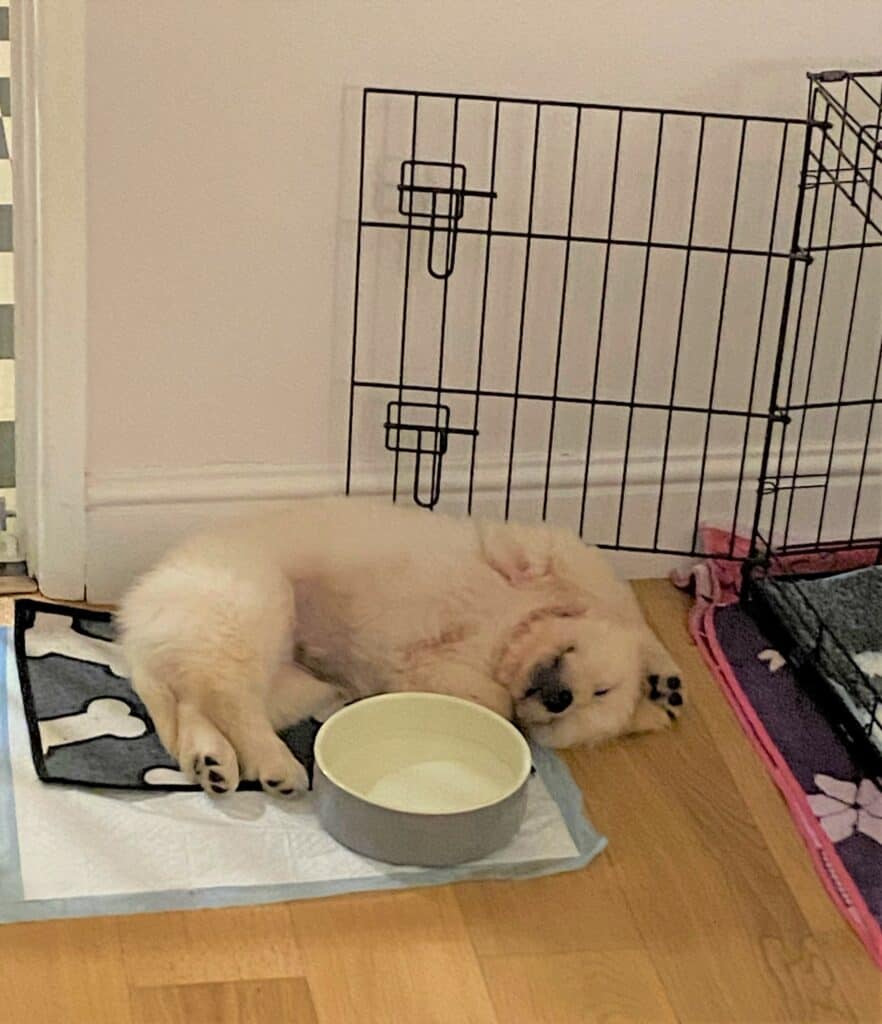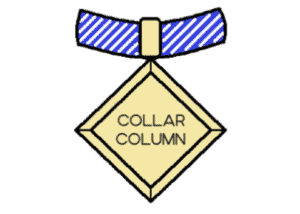Toilet training your puppy is one of the more trickier elements of owning a puppy and some dog parents reach for puppy pads to help. Well-known dog experts such as Cesar Millan have endorsed their use, but if you are crate training your puppy, should you put them in the puppy’s crate?
Do not put visible puppy pads in your puppy’s crate. If you do, you are at great risk of teaching your puppy to go to the toilet in its crate, which is exactly what you don’t want. However, there is a scenario where they can be useful which is placing pads under any bedding, and most importantly OUT OF SIGHT.
Crate training your puppy is incredibly useful for many reasons, but one of the most useful elements is using it as an aid in teaching your puppy where to go to the toilet i.e outside. So let’s discuss in more detail the thinking behind not using pads in the crate and why placing one under bedding out of sight might serve a purpose.

Pads being used to soak up Albus’ digging in the water bowl!
No Puppy Pads On Show In the Crate
The basic principle of not placing pads in your puppy’s crate (at least on show) is that the crate tries to recreate the den from when they were born. From around 3 weeks of age, a puppy will leave the den to go to the toilet elsewhere, so placing a pee pad in the crate will encourage them to use the crate as its toilet, which they won’t enjoy as they like to keep the area they sleep clean, and will cause you a lot of clean up jobs.
It is also important to stress at this point that you need to buy an appropriately sized crate where it isn’t too big for the puppy as they will use the opposite end of the crate to go to the toilet as it’s far enough away, so dirtying where it sleeps becomes less of an issue. I.e Don’t get an extra large crate from day one for a retriever puppy. It will be too large for the puppy’s current size.
Another risk of leaving a puppy pad in the crate is that it presents a choking hazard. If you are crating your puppy, the likelihood is you are in another room or you have gone out, so crating your puppy is essential as they are too young to know what isn’t good for them. So placing a potential choking hazard in with them if chewed up (which we know puppies love to do) whilst you are away is risky.
See my post on How Long Can Puppies Hold Their Poop at Night? CLARIFIED!
A Work Around
However, there is a scenario where puppy pads can be put to use in the crate. If you are using a vet bed or other bedding that covers the base of the crate, placing pads under the bedding, completely out of sight, will help tremendously if your puppy does have an accident in the crate as it will aid with clean up and allows the puppy to be more comfortable. It makes things a lot quicker, especially if you’re sorting it all out at night!
It is essential the pads are out of sight for the reasons above. They may see even a bit of it and then associate it with pads seen elsewhere in the house used for training and then go to the toilet in the crate. Again, it could also be a choking hazard. This isn’t to say the method is foolproof and the puppy may find it which again may present a chewing/choking hazard. By the time the pup has gone about ‘reorganising’ the interior of the crate, the now likely screwed-up puppy pad is less likely to remind them to wee on it, and rather just an item to be destroyed. So just bear that in mind.
Another benefit of using them under the bedding is that they will soak up any dog urine and stop it from making contact with the crate itself. The issue here is that if it was to make contact, the scent of urine to a dog’s nose is incredibly difficult to remove and requires products outside the usual disinfectants and household products to remove it. If the scent remains, the dog will pick up on this and continue to wee on that spot and cause you a lot of work and setback in their toilet training. A good way to remove the scent though is the use of white vinegar.
With Albus, we used this method and it worked well. You could take the wet pad straight out and replace with spare vet bed and a new pad. He didn’t find the puppy pads most of the time, and when he did, it was rare he chewed them up and it created a quicker clean-up job with minimal setbacks in his toilet training.
Summary
At the end of the day it’s personal preference and a lot depends on your dog. Ie. are they a destroyer and likely to chew up the pee pad creating a choking risk? If they aren’t, then I would consider the vet bed, out of sight, under the bedding. However, no pad at all is also absolutely great, but make sure to have good, specific cleaning products to remove the scent and be prepared for a slightly longer clean-up. The main takeaway however is to make sure the puppy has no idea if the pad is there or not to begin with.

